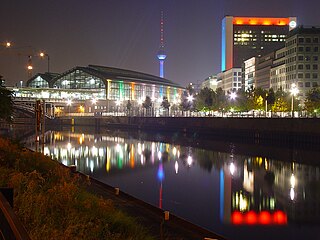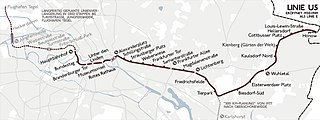Station of the Berlin U-Bahn
Kaulsdorf-Nord is a surface level Berlin U-Bahn station located on the ![]() . Alternate trains from Hauptbanhof will end at this station.
. Alternate trains from Hauptbanhof will end at this station.
Kaulsdorf-Nord is a surface level Berlin U-Bahn station located on the ![]() . Alternate trains from Hauptbanhof will end at this station.
. Alternate trains from Hauptbanhof will end at this station.
Kaulsdorf-Nord | |||||||||||
|---|---|---|---|---|---|---|---|---|---|---|---|
 | |||||||||||
| General information | |||||||||||
| Line(s) | U5 | ||||||||||
| Platforms | 2 side platforms | ||||||||||
| Tracks | 2 | ||||||||||
| Construction | |||||||||||
| Structure type | Surface Level | ||||||||||
| History | |||||||||||
| Opened | 1 July 1989 | ||||||||||
| Previous names | Albert-Norden-Straße (1989-1991) | ||||||||||
| Services | |||||||||||
| |||||||||||
The station was originally named Hellersdorfer Straße in the planning stage. The station opened in July 1989, just a few months before the fall of the Berlin Wall. The eastern extension of the line E was one of the last major construction projects of the former German Democratic Republic.
In the beginning the name was Albert-Norden-Straße. On 2 October 1991, after the reunification the road was changed to Cecilienstraße while the station's name is renamed to Kaulsdorf Nord. [1]

The Berlin U-Bahn is a rapid transit system in Berlin, the capital and largest city of Germany, and a major part of the city's public transport system. Together with the S-Bahn, a network of suburban train lines, and a tram network that operates mostly in the eastern parts of the city, it serves as the main means of transport in the capital.

The Berlin S-Bahn is a rapid transit railway system in and around Berlin, the capital city of Germany. It has been in operation under this name since December 1930, having been previously called the special tariff area Berliner Stadt-, Ring- und Vorortbahnen. It complements the Berlin U-Bahn and is the link to many outer-Berlin areas, such as Berlin Brandenburg Airport. As such, the Berlin S-Bahn blends elements of a commuter rail service and a rapid transit system.

U5 is a line on the Berlin U-Bahn. It runs from Hauptbahnhof in Mitte eastwards through Alexanderplatz, Friedrichshain, Lichtenberg and Friedrichsfelde, surfaces in Biesdorf-Süd to pass Kaulsdorf and Hellersdorf above ground and finally reaches city limits at Hönow.
The U7 is a rail line on the Berlin U-Bahn. It runs completely underground for a length of 31.8 kilometres (19.8 mi) through 40 stations and connects Spandau, via Neukölln, to Gropiusstadt and Rudow. The line was originally the south-eastern branch of the Nord-Süd-Bahn (U6) that ran between the branching point at Belle-Alliance-Straße (Mehringdamm) and Grenzallee; however, in the 1960s, this stretch was separated from the rest of the line and extended at each end to form a new line. As of 2007, the U7 is Berlin's longest underground line, both in terms of absolute length and total travel time, and one of the longest (entire) subterranean lines in Europe.

Marzahn is a locality within the borough of Marzahn-Hellersdorf in Berlin. Berlin's 2001 administrative reform led to the former boroughs of Marzahn and Hellersdorf fusing into a single new borough. In the north the Marzahn locality includes the neighbourhoods of Bürknersfelde and Ahrensfelde, an overbuilt strip of land which once had belonged to the Brandenburg municipality of Ahrensfelde and was incorporated into Berlin in 1990.

Hellersdorf is a locality in the borough of Marzahn-Hellersdorf in Berlin. Between 1986 and Berlin's 2001 administrative reform, it was a borough in its own right, consisting of the current area of Hellersdorf as well as Kaulsdorf and Mahlsdorf.

Kienberg is a station on the U-Bahn in the German capital city of Berlin. It is located on the line.

Louis-Lewin-Straße is a surface level Berlin U-Bahn station in the German capital city of Berlin. It is part of the Berlin U-Bahn; the station is located on the line.

Französische Straße was a Berlin U-Bahn underground station on the line located under the street Friedrichstraße in central Berlin.

Mehringdamm is a Berlin U-Bahn station located on the and the .

Konstanzer Straße is a Berlin U-Bahn station located on line in the Wilmersdorf district.

Berlin-Charlottenburg is a railway station in the Charlottenburg district of Berlin. The station is located on the Stadtbahn line, served by the , , , and lines of the Berlin S-Bahn, as well as by Regional-Express and Regionalbahn trains operated by Deutsche Bahn. The U-Bahn station Wilmersdorfer Straße (U7) can be reached via short footpath.

Kaulsdorf is a locality within the borough Marzahn-Hellersdorf of Berlin. Kaulsdorf was incorporated into Greater Berlin by the Prussian Greater Berlin Act in 1920. From then on it belonged to the former borough of Lichtenberg until 1979, when it became part of the then borough of Marzahn. In 1986 Marzahn's eastern areas, including Kaulsdorf, were separated to form the new Borough of Hellerdorf, which was merged in 2001 to form the current borough. Kaulsdorf has, as of 2006, a population of 18,822 and encompasses an area of 8,7 km².

Fredersdorf is a railway station located in Fredersdorf-Vogelsdorf, in the Märkisch-Oderland district of Brandenburg. It is served by the S-Bahn line .

The North–South S-Bahn Tunnel is the central section of the North–South transversal Berlin S-Bahn connection crossing the city centre. It is not to be confused with the Tunnel Nord–Süd Fernbahn, the central tunnel part of the North–South main line used by intercity and regional trains. The S-Bahn North–South line encompasses the route from Bornholmer Straße and Gesundbrunnen via Friedrichstraße and Anhalter Bahnhof to Papestraße and Schöneberg.

Mahlsdorf is a locality (Ortsteil) within the Berlin borough (Bezirk) of Marzahn-Hellersdorf. Until 2001 it was part of the former borough of Hellersdorf.

Biesdorf is a locality (Ortsteil) within the Berlin borough (Bezirk) of Marzahn-Hellersdorf. Until 2001 it was part of the former borough of Marzahn.

The VnK line is a railway line in Berlin that formerly connected the Berlin Stadtbahn in Rummelsburg with the Prussian Eastern Railway in Kaulsdorf. The acronym may stand for Verbindung nach Kaulsdorf ; Verbindung nach Küstrin or von und nach Kaulsdorf or Küstrin are common interpretations. The western part of the line is still in operation. This single-track electrified line links the Stadtbahn with the Berlin outer ring.

The Berlin U-Bahn originated in 1880 with Werner Siemens' idea to build an urban railway in Berlin. During the nine years after the German Empire was founded, the city's population grew by over one-third and traffic problems increased. In 1896, Siemens & Halske began to construct the first stretch of overhead railway. On 1 April 1897, the company began construction of an electric underground railway. The Berliner Verkehrs Aktiengesellschaft (BVG) was formed in 1928, and took over further construction and operation of the network. In 1938, the company was renamed Berlin Transport Company; the original acronym, however, remained. Since 1994, the BVG has been a public company.

Joachim-Mähl-Straße is a metro station in Niendorf, Hamburg on the Hamburg U-Bahn line U2.